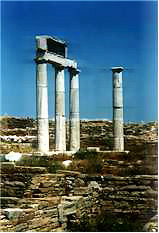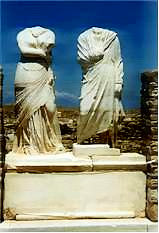 |
|
| |
Tour 3: Athens with Island Hopping (7-8 nights) 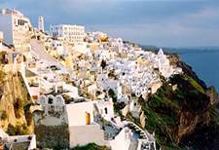 This
program includes 1-2 nights stay in Athens with sightseeing, a visit
to cape Sounion and an Athens by night. Also includes a seven day
tour to four famous Greek islands, Mykonos, Dilos, Santorini and Crete. This
program includes 1-2 nights stay in Athens with sightseeing, a visit
to cape Sounion and an Athens by night. Also includes a seven day
tour to four famous Greek islands, Mykonos, Dilos, Santorini and Crete.ATHENS SIGHTSEEING Your expert guide takes you to Constitution Square , the Tomb of the Unknown Soldier, the Acropolis (visit), the Theatre of Dionyssos, Hadrian's Arch, the Temple of Olympian Zeus (visit), the Olympic Stadium, the Royal Palace, the Academy, the University, and the National Library. CAPE SOUNION  Afternoon drive along the scenic coastal road through the wonderful
beach resort areas of Glyfada, Vouliagmeni and Varkiza, arriving at
the southern tip of Attica, Cape Sounion , where the white marble
pillars of the Temple of Poseidon still stand. This is a photographers'
delight so bring your camera! Early evening return to hotel.
Afternoon drive along the scenic coastal road through the wonderful
beach resort areas of Glyfada, Vouliagmeni and Varkiza, arriving at
the southern tip of Attica, Cape Sounion , where the white marble
pillars of the Temple of Poseidon still stand. This is a photographers'
delight so bring your camera! Early evening return to hotel.ATHENS BY NIGHT An impressive evening with dinner and traditional folk dances at a typical Greek taverna. (In the winter, a visit to the Mikrolimano yacht harbor is included). SEVEN DAY ISLAND TOUR Day 1: Breakfast in the early morning. Time maybe for some shopping till your departure transfer to Piraeus port to catch the boat leaving to the Islands Of Winds, Mykonos! The island that will bewitch you with its natural beauties, captivate your heart and give you unforgettable moments of fun and pleasure. Transfer to the Hotel. Free afternoon to enjoy a walk in the town. Day 2: Breakfast to get energy! Pick up for your transfer to the port were the boat leave to the wonderful sacred Island of Delos right across Mykonos Island. The ancient holy island of Delos is a vast archeological site. For many centuries it was the religious centre of Greece. It was the centre of the circle describing the Cyclades and the birthplace of Apollo and Artemis. History tells us, however, that the island was probably first inhabited in 3000 B.C. and at the end of the fourth century it developed into a major commercial center, competing with Rhodes. By Roman times, Delos had roughly 25,000 inhabitants, more or less. Archaeologists uncovered evidence of Ioanians living here in the 7th century B.C., followed through the centuries by Athenians, Delians, Egyptians, Syrians, and Romans. It was the jewel of the Aegean Sea and was the summer home of the rich and famous of the time.
Return from your excursion of Delos. Evening free to relax and enjoy your new surrounds. Day 3: Breakfast early morning and get ready for your departure transfer to Mykonos port to get to the boat that will take you to the next Jewel of the Greek Islands. Santorini with its unique Sunset! 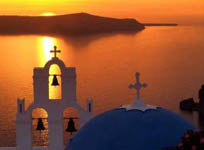
Santorini is a unique island. It is one of the few places in the world in which you have the enchanting sensation to be dominated by Nature. An imperious Nature, spectacular, relaxing but disquieting, arid but eloquent, sometimes cruel, omnipresent in each aspect of every day's life. The rhythm of the hours here is not dictated by the working hours or by the clock-hands, but by natural events, that will take you from the moment you wake up until the moment you close your eyes to fall asleep. The poetry of dawn, the fresh morning dew, the blinding mid-day bright sun-beams, the colors of the sunset, a cloud of mist in the twilight, the romanticism of the full moon, here get a richer meaning and richer impact over your imagination. Transfer to Accommodation. Evening free to enjoy most famous Sunset of the Mediterranean sea. Day 4: Breakfast and be ready for your pick up to the Excursion of Ancient Thira. Ancient Thira, the Classical city of the island is located on Mesa Vouno, 396 m. above sea level. It was founded in the 9th century B.C. by Dorian colonists whose leader was Theras, and continued to be inhabited until the early Byzantine period. The most important monuments of the site are: Sanctuary of Artemidoros The Sanctuary of Artemidoros, entirely hewn in the rock, was founded by Artemidoros of Perge. Engraved on the face of the rock are epigrams and inscriptions, as well as the symbols of the gods worshipped. Agora The Agora lies almost at the centre of the city. Its southern part was actually the commercial centre and the middle one was the administrative centre. The northern part was added in the Roman period and included a portico, monuments and temple-like buildings, erected in honor of distinguished persons. Royal Stoa  The
Royal Stoa (46 x 10 m.) was built in the time of Augustus (1st century
A.D.), in the SW part of the Agora. The main entrance is on the east
side, towards the Agora and the roof was supported by an interior
Doric colonnade along the axis of the building. Statues of members
of the Ceasar's family were erected in the north part. The
Royal Stoa (46 x 10 m.) was built in the time of Augustus (1st century
A.D.), in the SW part of the Agora. The main entrance is on the east
side, towards the Agora and the roof was supported by an interior
Doric colonnade along the axis of the building. Statues of members
of the Ceasar's family were erected in the north part.Temple of Dionysos Temple of Dionysos. Small, Doric temple with a small cella and pronaos, built on an artificial terrace to the north of the Agora. Dated to the 3rd century B.C. (Hellenistic period). Sanctuaries at the SE edge of the city
Sanctuary of Apollo Karneios The Sanctuary of Apollo Karneios, dated to the 6th century B.C., is partially hewn from the rock and partially built on an artificial terrace. Gymnasium of the youths Gymnasium of the youths. It lies at the south edge of the city and dates from the 2nd century A.D. A small cave, partially hewn from the rock, was dedicated to Hermes and Heracles. Cemeteries of Ancient Thera  Cemeteries
of Ancient Thera. They are located on the slopes of the Sellada, on
either side of the roads that led to the north and south harbours
of the ancient city, the modern villages of Kamari and Perissa, respectively.
The graves uncovered span the long period between the Geometric and
Roman times. Cemeteries
of Ancient Thera. They are located on the slopes of the Sellada, on
either side of the roads that led to the north and south harbours
of the ancient city, the modern villages of Kamari and Perissa, respectively.
The graves uncovered span the long period between the Geometric and
Roman times. Theatre The Theatre lies to the SE of the Agora. It was constructed in the Ptolemaic period (3rd century B.C.) and in its original form had a circular orchestra. During alterations in the 1st century A.D., the stage was extended and took over part of the original orchestra. Return in evening free to relax. Day 5: Breakfast and transfer to the port Of Santorini to take the fast boat that will take your last Island destination of Crete! The largest and beautiful Island of Greece. 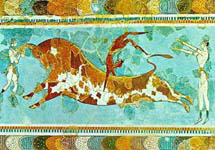 Crete
is a mountainous island, the largest of the Greek islands and the
fifth largest island in the Mediterranean, lies south in Greece separating
the Aegean from Libyan Sea, the southest part of Europe, a link between
three continents Asia, Africa and Europe. Crete
is a mountainous island, the largest of the Greek islands and the
fifth largest island in the Mediterranean, lies south in Greece separating
the Aegean from Libyan Sea, the southest part of Europe, a link between
three continents Asia, Africa and Europe. Boat arrives at Heraklion port were you’ll be transfer to the Hotel. Rest of day Free to explore Heraklion. Day 6: Breakfast and pick up for your transfer to the Excursion of Knossos! The Minoan Palace of Knossos lies at a distance of 5 km from the town centre of Iraklion along the road to Archanes. The site itself includes the Palace of Knossos, The Minoan Houses, the "Little Palace", the "Royal Villa", the villa "Dionysos" with famous Roman mosaics, the south Royal Temple - Tomb and the "Caravanserai". The Palace and the Minoan houses are open for visits to the public. It is well known that the area lies on a great seismic site. The Palace had been destroyed time after time and always emerged from its ruins more magnificent than before until the last time that there was no recovery. Excavations showed that the area was inhabited since the Neolithic times (6000 BC and perhaps even earlier) and verified that the Neolithic levels of Knossos are amongst the deepest in Europe. An important Pre Palace already existed on this Neolithic site as far as 3000 BC. while the first Palace was built around 2000 BC and destroyed 300 years later. On the same site a new Palace was built, more elaborate than the previous, only to be severely damaged from an earthquake one hundred years latter. During this period we see the development of a series of satellite buildings like the "Little Palace", the "Royal Villa" and the "South House". Knossos has now developed into a large city whose population - judged by the adjacent cemeteries - must have not been less than 100 000 inhabitants. The Palace now lives and prospers until the next disaster of around 1450 BC connected to the volcanic eruption of Santorini. Following this event, it is restored once more and used by the Achaean sovereign until at least 1380 BC although other city states in Crete had already been destroyed. After its final destruction the palace was not used again except for the "temple of Rhea" in later historical times. 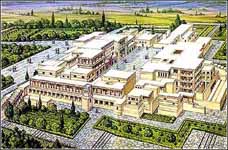 Knossos
survived through the historical times as a great city - state until
the first Byzantine times. Its final decline came during the Middle
Ages where it was diminished to an unimportant small village with
the name "Makrys Toihos". Knossos
survived through the historical times as a great city - state until
the first Byzantine times. Its final decline came during the Middle
Ages where it was diminished to an unimportant small village with
the name "Makrys Toihos". Its central court divides the Palace of Knossos into two wings, the West and the East. The West wing where the visitor enters today is where the religious and official staterooms are found while domestic rooms and workshops occupy the East wing. Day 7: Breakfast. Pick up for transfer to Heraklion port to take the boat back to Athens. Return back to home with lots of memories to take of your trip to Greece! |
| Copyright www.lvyoul168.cn,All Rights Reserved by China Business Network If you have any queries and suggestion, Please contact the Webmaster . |
